Transfer of a Case From One Court to Another?
By Vkeel Team
Table of Contents
- Introduction
- Grounds for Transfer of A Case
- Objectives for Transfer of Cases in Courts
- Power of the Court to Transfer a Case from One Court to Another
- Procedure for Transfer of a Case From One Court to Another
- Comparing the Different Types of Court Transfers
- Challenges of Transferring a Case from One Court to Another
- Benefits of Transferring a Case from One Court to Another
- Why do you need a Lawyer for Transferring a Case?
- Conclusion
Introduction
Transferring a case from one court to another is a process that can be complicated and time-consuming. It is important to understand the process and the legal requirements for transferring a case from one court to another. This article will provide an overview of the process and the legal requirements for transferring a case from one court to another. It will also provide tips and advice on how to successfully transfer a case from one court to another.
Grounds for Transfer of A Case
A case may be transferred from one court to another for a variety of reasons. Generally, a court may transfer a case if it determines that the transfer is in the interest of justice.
The most common grounds for transferring a case are:
1. Convenience: A court may transfer a case if it determines that the transfer would be more convenient for the parties involved. This may be the case if the parties are located in different jurisdictions or if the witnesses or evidence are located in a different jurisdiction.
2. Jurisdiction: A court may transfer a case if it determines that the court to which the case is being transferred has jurisdiction over the matter. This may be the case if the parties are located in different jurisdictions or if the dispute involves a matter that is governed by the laws of a different jurisdiction.
3. Forum Non Conveniens: A court may transfer a case if it determines that the court to which the case is being transferred is a more appropriate forum for the dispute. This may be the case if the parties are located in different jurisdictions or if the dispute involves a matter that is more closely related to the laws of a different jurisdiction.
4. Change of Venue: A court may transfer a case if it determines that the court to which the case is being transferred is a more appropriate venue for the dispute. This may be the case if the parties are located in different jurisdictions or if the dispute involves a matter that is more closely related to the laws of a different venue.
5. Consolidation: A court may transfer a case if it determines that the case should be consolidated with another case that is pending in a different court. This may be the case if the cases involve similar issues or parties.
6. Appeal: A court may transfer a case if it determines that the case should be heard by an appellate court. This may be the case if the parties have filed an appeal of a lower court’s decision.
Objectives for Transfer of Cases in Courts
The objective of transferring cases in courts is to ensure that justice is served in a timely and efficient manner. Transferring cases from one court to another can be beneficial in a variety of ways. It can help to reduce the backlog of cases in a particular court, ensure that the case is heard by a judge who is more familiar with the relevant laws, and provide a more impartial and unbiased decision. Additionally, transferring cases can help to ensure that the parties involved receive a fair and just outcome.
Transferring cases is a complex process that requires careful consideration and evaluation. The court must consider the facts of the case, the applicable laws, and the potential impact of the transfer on the parties involved. The court must also consider the availability of resources and the potential for a conflict of interest. Ultimately, the court must make a decision that is in the best interest of justice.
By transferring cases in courts, the judicial system can ensure that justice is served in a timely and efficient manner. This helps to ensure that the parties involved receive a fair and just outcome.
Power of the Court to Transfer a Case from One Court to Another
In general, a court may transfer a case to another court if it is in the interest of justice to do so. This power is typically used when the court in which the case is pending does not have jurisdiction over the matter, or when the court believes that the case would be better served by another court.
For example, a court may transfer a case to another court if the parties involved in the case are located in different jurisdictions. In such a situation, the court may transfer the case to the court in the jurisdiction where the parties are located. This ensures that the parties have access to the court in their own jurisdiction and that the court is familiar with the laws of that jurisdiction.
In addition, a court may transfer a case to another court if the court believes that the case would be better served by another court. This could include a situation where the court believes that the case would be better served by a court with more experience in the particular area of law, or a court with more resources to handle the case.
Finally, a court may transfer a case to another court if the court believes that the case would be better served by a court with a different set of rules or procedures. This could include a situation where the court believes that the case would be better served by a court with different rules of evidence or a different set of procedural rules.
Procedure for Transfer of a Case From One Court to Another
Transferring a case from one court to another is a process that is governed by the rules of civil procedure. The process is initiated when a party to the case files a motion to transfer the case to a different court. The motion must be filed in the court where the case is currently pending.
The motion must include the reasons why the case should be transferred. Generally, the court will consider factors such as the convenience of the parties, the location of witnesses, and the availability of evidence. The court may also consider the expertise of the court in the subject matter of the case.
Once the motion is filed, the court will issue an order setting a hearing date. At the hearing, the parties will present their arguments for and against the transfer. The court will then issue a ruling on the motion.
If the court grants the motion, it will issue an order transferring the case to the new court. The order will include instructions for the parties on how to proceed in the new court.
The parties must then file the necessary documents in the new court. This includes the original complaint, any pleadings that have been filed, and the order transferring the case. The parties must also provide the new court with copies of any documents that have been filed in the original court.
Once the documents have been filed in the new court, the case will proceed as if it had been filed in that court from the beginning. The new court will then set a hearing date and proceed with the case.
Comparing the Different Types of Court Transfers
When it comes to transferring a case from one court to another, there are several different types of court transfers that can be used. Depending on the circumstances, one type of transfer may be more appropriate than another. In this article, we will discuss the different types of court transfers and the situations in which they are typically used.
The first type of court transfer is a change of venue. This type of transfer is used when a case needs to be moved from one court to another due to a conflict of interest or other issue that would prevent a fair trial in the original court. For example, if a case involves a judge who is related to one of the parties, a change of venue may be necessary to ensure a fair trial.
The second type of court transfer is a transfer of jurisdiction. This type of transfer is used when a case needs to be moved from one court to another due to the fact that the original court does not have the authority to hear the case. For example, if a case involves a federal law, it may need to be transferred to a federal court.
The third type of court transfer is a transfer of cause. This type of transfer is used when a case needs to be moved from one court to another due to the fact that the original court does not have the expertise or resources to properly handle the case. For example, if a case involves a complex medical issue, it may need to be transferred to a court that specializes in medical cases.
Finally, the fourth type of court transfer is a transfer of convenience. This type of transfer is used when a case needs to be moved from one court to another due to the fact that the original court is too far away or too busy to handle the case. For example, if a case involves a witness who lives in another state, it may need to be transferred to a court that is closer to the witness.
In conclusion, there are several different types of court transfers that can be used depending on the circumstances. A change of venue is used when a case needs to be moved from one court to another due to a conflict of interest or other issue that would prevent a fair trial in the original court. A transfer of jurisdiction is used when a case needs to be moved from one court to another due to the fact that the original court does not have the authority to hear the case.
A transfer of cause is used when a case needs to be moved from one court to another due to the fact that the original court does not have the expertise or resources to properly handle the case. Finally, a transfer of convenience is used when a case needs to be moved from one court to another due to the fact that the original court is too far away or too busy to handle the case.
Challenges of Transferring a Case from One Court to Another
Transferring a case from one court to another can be a complex process that involves a number of challenges. The most common challenges include the following:
1. Jurisdiction: The court to which the case is being transferred must have jurisdiction over the matter. This means that the court must have the authority to hear the case and make a ruling. If the court does not have jurisdiction, the transfer will not be allowed.
2. Timing: The timing of the transfer is also important. If the case is transferred too late, it may be dismissed due to a lack of jurisdiction or because the statute of limitations has expired.
3. Cost: Transferring a case from one court to another can be expensive. The court may require the parties to pay filing fees, court costs, and other expenses associated with the transfer.
4. Evidence: The court to which the case is being transferred may not have access to all of the evidence that was available in the original court. This can make it difficult for the court to make a ruling.
5. Witnesses: Witnesses may not be available to testify in the new court. This can make it difficult for the court to make a ruling without hearing from all of the relevant witnesses.
6. Precedent: The court to which the case is being transferred may not have the same precedents as the original court. This can make it difficult for the court to make a ruling that is consistent with the law.
Transferring a case from one court to another can be a complex process that involves a number of challenges. It is important to understand these challenges before attempting to transfer a case.
Benefits of Transferring a Case from One Court to Another
Transferring a case from one court to another can be beneficial for both parties involved. This process, known as a change of venue, can provide a more impartial and fair hearing for the case. Here are some of the advantages of transferring a case from one court to another.
First, a change of venue can provide a more impartial jury. When a case is transferred to a different court, the jury pool is often larger and more diverse. This can help ensure that the jury is more representative of the community and less likely to be biased in favor of one party or the other.
Second, a change of venue can provide a more experienced judge. In some cases, the judge in the original court may not have the necessary experience or expertise to handle the case. By transferring the case to another court, the parties can be assured that the judge is well-versed in the relevant laws and can provide a fair and impartial ruling.
Third, a change of venue can provide a more convenient location for the parties involved. In some cases, the original court may be located in a different city or state than the parties involved. By transferring the case to another court, the parties can save time and money by avoiding the need to travel long distances.
Finally, a change of venue can provide a more efficient process. In some cases, the original court may be backlogged with cases, resulting in long delays. By transferring the case to another court, the parties can be assured that their case will be heard in a timely manner.
Overall, transferring a case from one court to another can provide a number of benefits for both parties involved. By providing a more impartial jury, experienced judge, convenient location, and efficient process, a change of venue can help ensure that the case is heard fairly and efficiently.
Why do you need a Lawyer for Transferring a Case?
A lawyer is an essential part of the process when transferring a case. This is because a lawyer can provide legal advice and guidance throughout the process, ensuring that all parties involved are aware of their rights and obligations. A Civil Lawyer or Criminal Lawyer can also help to ensure that the transfer is done in accordance with the law, and that all relevant documents are properly filed and submitted.
Additionally, a lawyer can provide representation in court if necessary, and can help to negotiate a settlement if the parties involved cannot reach an agreement. In short, a lawyer is an invaluable asset when transferring a case, and can help to ensure that the process is completed in a timely and efficient manner.
Conclusion
In conclusion, transferring a case from one court to another is a complex process that requires careful consideration of the facts and circumstances of the case. It is important to understand the differences between the two courts and the applicable laws in order to ensure that the transfer is done properly. Additionally, it is important to consider the potential impact of the transfer on the parties involved and the potential costs associated with the transfer. Ultimately, the decision to transfer a case should be made with the best interests of all parties in mind.
Disclaimer:
The information provided in the article is for general informational purposes only, and is not intended to constitute legal advice or to be relied upon as a substitute for legal advice. Furthermore, any information contained in the article is not guaranteed to be current, complete or accurate. If you require legal advice or representation, you should contact an attorney or law firm directly. We are not responsible for any damages resulting from any reliance on the content of this website.










